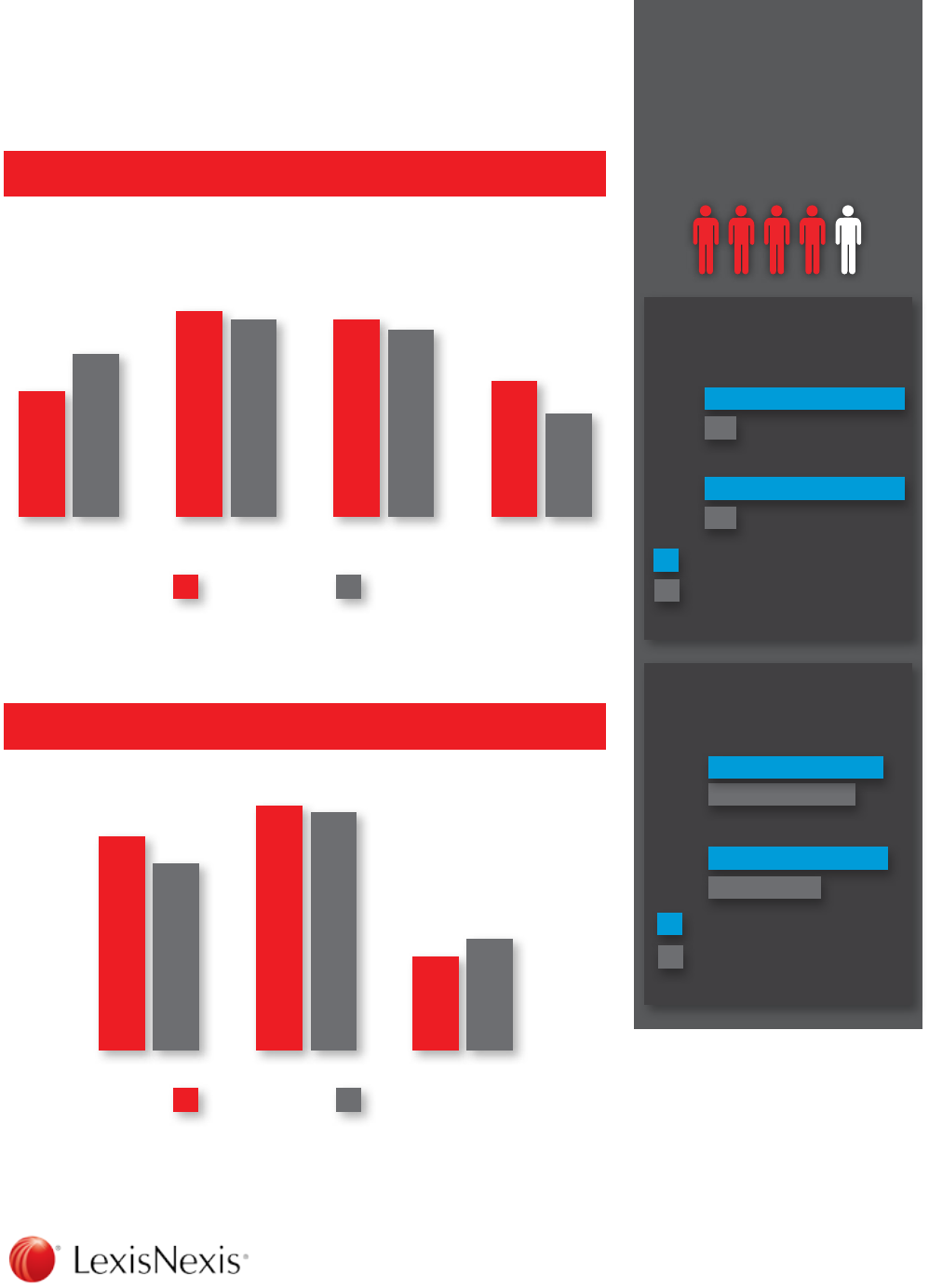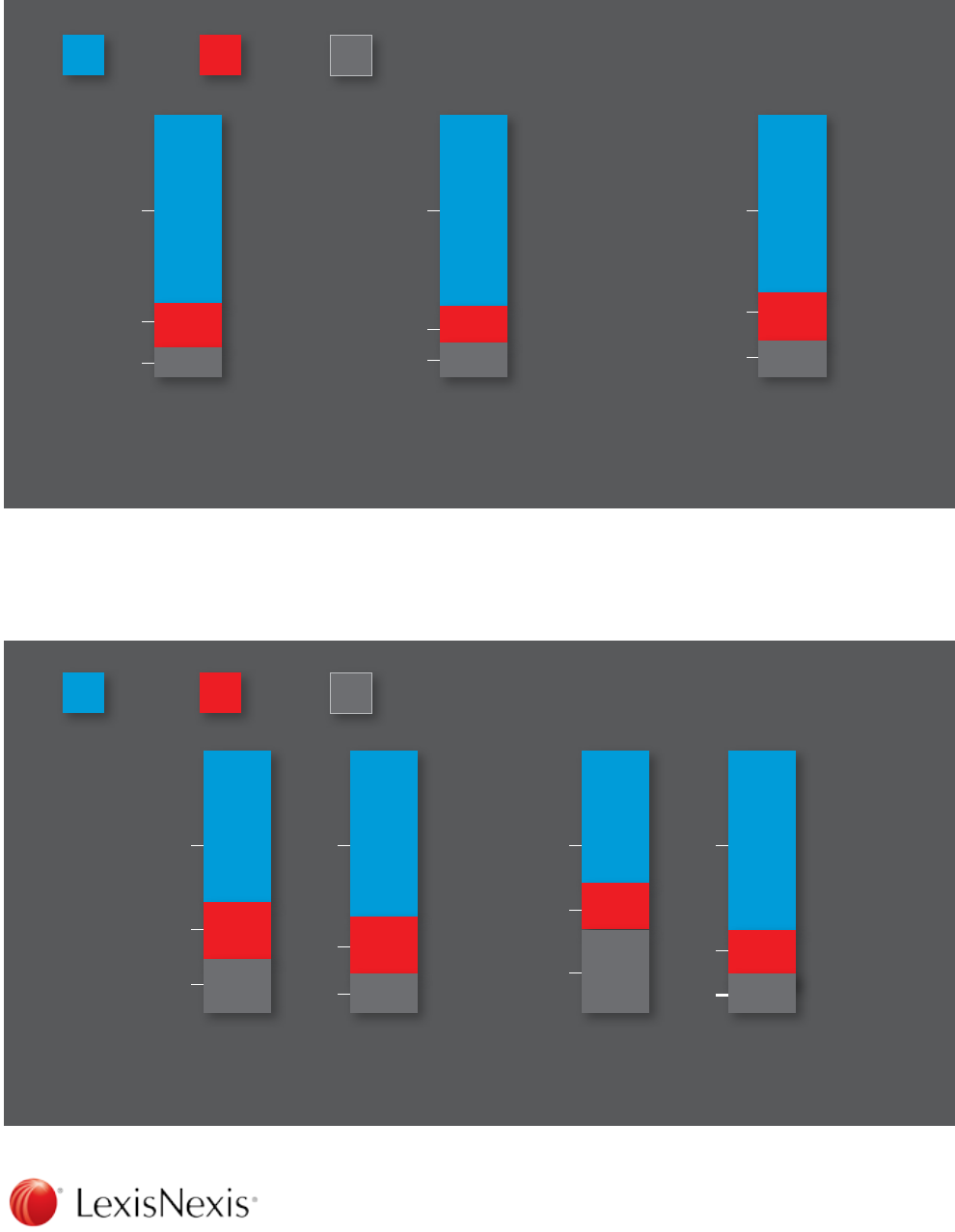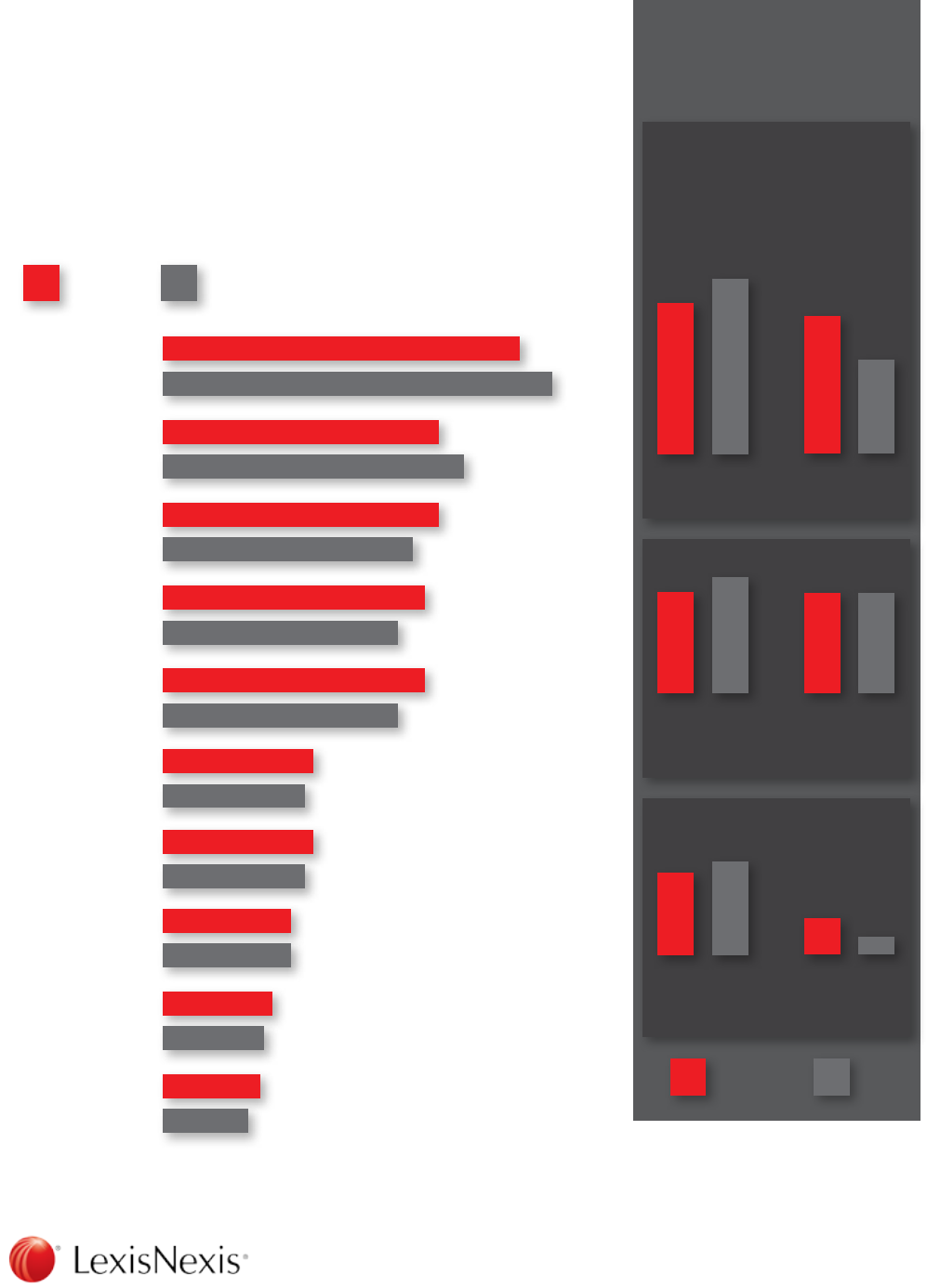
Research
Social Media Use in Law Enforcement:
Crime prevention and investigative activities
continue to drive usage.
November 2014

Social Media Use in Law Enforcement:
LexisNexis
®
2014 Comprehensive Results
2
Background and methodology
Overview
Social media is increasingly valuable to the way law enforcement
professionals operate in both crime prevention and investigation. However,
as social media use becomes more prevalent, there remain many questions
regarding how exactly it is utilized to optimal effect in criminal investigations.
LexisNexis
®
, in a follow-up to its initial study in 2012, sought to further
examine the law enforcement community’s understanding of, and ongoing
efforts to leverage social media. The LexisNexis 2014 Social Media Use in
Law Enforcement report looks at current practices and processes and how
the landscape has changed over the last two years in addition to new survey
research areas.
Research Objectives
To assess the law enforcement community – particularly those involved in
crime investigations – and their understanding of, proclivity to use, and actual
use of social media in law enforcement efforts.
To understand current resources and processes being used by law
enforcement when leveraging social media intelligence in investigations.
Methodology
An online study was conducted among the PoliceOne.com community in
February of 2014. LexisNexis was not identified as the sponsor. Respondents
must have been users of social media on the job. Respondents included federal,
state and local law enforcement professionals, representing a good mix of age,
geographies, experience levels and ranks.
Executive summary
Law enforcement professionals throughout the U.S. are increasingly
turning to modern technology, including social media, to aid in carrying
out their public safety mission, with a primary goal of preventing and
investigating crime.
The frequency of social media use by law enforcement, while already
high, is projected to rise even further in the coming years. Yet, few agencies
have adopted formal training, policies or have dedicated staff in place,
resulting in barriers to consistent and broad application throughout all
of law enforcement.
Eight out of every
10 law enforcement
professionals (81%)
actively use social
media as a tool in
investigations.
67% of respondents
indicate that social
media monitoring is
a valuable process in
anticipating crimes.
When used as an
investigatory tool,
73% believe social
media can help solve
cases more quickly.
Over half (52%) of agencies still don’t
have a formal process for using social
media for investigations. The single
biggest barrier to use is a lack of access
during work hours.
25% now use it
daily, a sharp
increase from
16% in 2012.
The reliance on the
technology is expected
to expand, with 78% of
current users planning
to use it even more in
the coming year.
The most commonly used social
media channels are: Facebook (93%)
and YouTube (67%).
67%
29%
93%
50%
Twitter usage increased significantly,
to 50% from 29% in 2012.
2012
2014
25%
78%
67%
73 %

Social Media Use in Law Enforcement:
LexisNexis
®
2014 Comprehensive Results
3
Other pertinent findings from the 2014 survey reveal how
law enforcement increasingly relies on social media tools
to prevent crime, accelerate case closures and develop a
dialogue with the public.
Activity Insights/Advantages
Anticipating crimes
Closing investigations
quickly
Two-way public
communications
Social media use in crime prevention is
increasing both in use and importance to the
law enforcement personnel utilizing it.
Law enforcement officers can use real-time
social media information to anticipate public
gatherings and protests and prepare in
advance to maintain the peace.
Survey respondents indicated several real-
world examples in which they prevented or
thwarted pending crime, including: stopping
an active shooter, mitigating threats toward
school students, executing outstanding arrest
warrants and actively tracking gang behavior.
73% believe using social media helps solve
crimes faster; up six percent from 2012.
Some positive examples cited by
respondents: juvenile runaway with an older
individual was found safe within hours by
tracking cell phone movements and Facebook
“check-ins”; speedy identification of suspects
when police post photos to various online
platforms and ability to connect suspects to
other suspects or other crimes by examining
posts, photos and “friends of friends.”
More than a third (34%) now notify the public
of crimes via social media, up 11% from 2012.
They notify the public with urgent, real-
time information and ask them to be on the
lookout for certain criminal suspects, their
cars and other identifying details.
Law enforcement personnel increasingly
reach out to the public via social media for
help in solving crimes, with 29% soliciting
crime tips. They also use it to alert the public
about emergencies (34%), to build positive
community and public relations (30%) and to
communicate about traffic issues (27%).
New information uncovered in
the 2014 survey centers around
how best to leverage social
media as a tool to communicate
information about emergencies
and events and includes the
following findings:
40% use it to monitor
special events
34% use it to notify the
public of crimes
34% use it to notify the
public of emergencies
or disasters
40%
34%
34%

Social Media Use in Law Enforcement:
LexisNexis
®
2014 Comprehensive Results
4
Social media use in criminal
investigations—overall
community
81%
81%
16%
39%
35%
44%
43%
16%
21%
daily
somewhat increase significant increase stay about the same
2012
2012
2014
2014
2-3 times/week 2-3 times/month less often
25%
32%
31% 31%
30%
19%
12%
69%
41%
51%
63%
2014
2012
2014
2012
investigative
crime investigation
non-investigative
crime anticipation
12%
12%
Social media use:
crime investigations vs. crime anticipation
Social media use:
investigative vs. non investigative
Frequency of and expected change in social media use
Social media is frequently used for investigations. Use of social media grew in
2014 and is expected to continue to grow, with 78% expecting to use it even
more over the next year.
Frequency of use of social media in investigations
Expected change of use in the next year
Among law enforcement professionals
who use social media, four of every five
use it for investigative purposes – this is
unchanged since 2012.

Social Media Use in Law Enforcement:
LexisNexis
®
2014 Comprehensive Results
5
Importance and value of using social media to investigate crime
The value of social media in investigations, both now and in the future, is abundant. Law enforcement professionals
often leverage personas and undercover accounts during investigations to follow subjects or collect evidence.
Social media as a means to solve and prevent crime
The value of social media in helping solve crimes more quickly and assisting in crime anticipation is increasing.
73%
67%
Agree Neutral Disagree
67% 61%73% 67%
2012 20122014
82% 80%
9%
11%
9%
9%
Social media in crime fighting &
investigative activities will be critically
important in the future
Creating personas or profiles on social
media outlets for use in law enforcement
activities is ethical
2014 2014
82%
10%
8%
Social media is a valuable tool
in investigating crimes
2014
2014
21%
17%
17%
17%
12%
22%
10% 16%
Information obtained via social media can
help me solve investigantions more quickly
Social media is a valuable tool in
anticipating crimes
Agree Neutral Disagree

Social Media Use in Law Enforcement:
LexisNexis
®
2014 Comprehensive Results
6
52%
70%
40%56%
77%
43%
2012
2012
20122014
2014
2014
21%
16%
34%
23%
10%
33%
27%
14%
26%
21%
13%
24%
Support of social media use by agency command staff and information credibility
Agency support of the use of social media and credibility of the information obtained through social media is on the
rise, but remains low overall despite increased usage and perceived value.
Comfort level of law enforcement personnel who use social media
Three quarters of law enforcement professionals are very comfortable using social media, showing a seven
percent increase over 2012 despite a decrease in availability of formal training. Interestingly, there are no significant
differences in comfort level across personal, agency, or geographic characteristics.
Agree Neutral Disagree
Agree Neutral Disagree
Those in command at my agency encourage
and support the use of social media
for investigation
Information obtained via
social media is credible
I am very comfortable using social media
for investigative purposes

Social Media Use in Law Enforcement:
LexisNexis
®
2014 Comprehensive Results
7
How law enforcement personnel learn to use social media to
aid investigations
Law enforcement professionals are predominately self-taught in using social
media for investigations and secondarily seek out colleagues. Formal training
has decreased slightly, with larger decreases in learning from colleagues and
utilizing information on community sites, and from the media or online.
How did you learn or discover how to use social media in your
investigations or crime monitoring activities?
71%
45%
37%
17%
12%
17%
4%
17%
2%
33%
47%
19%
14%
16%
45%
40%
40%
19%
19%
16%
10%
8%
Self Training
Personal Knowledge
Working with a colleague
Info available
on community sites
Info available
in media or online
Sessions at seminar
Training at a seminar
Self-driven training
Training given at
my agency
Info from different
vendors
75%
46%
37%
33%
32%
17%
18%
16%
9%
6%
Non-use of social media
by law enforcement
professionals
Lack of access to social media
channels is the single biggest driver
for non-use and has increased from
2012. Whereas, lack of knowledge
has decreased significantly as a
reason for not using social media.
Unable to access
during work hours
Don’t have enough
time to use
Agency policy
2012
2012
2014
2014
Don’t have enough
knowledge to use
Lack of support
from those
in command
Don’t personally
believe information
is useful

Social Media Use in Law Enforcement:
LexisNexis
®
2014 Comprehensive Results
8
Law enforcement officers share social media success stories
Law enforcement use of social media to anticipate criminal activity
experienced a significant increase in 2014 compared with the 2012 survey. It
is the second most commonly utilized social media activity, following crime
investigations, and currently more than half (51%) listen or monitor social
media activity for potential criminal activity. Two-thirds find social media a
valuable tool in anticipating crimes.
Law enforcement personnel are using social media tools in increasingly
unique and effective ways, from locating criminals and evidence to
communicating directly with the community about public safety matters.
Here are just a few of the creative ways they’ve employed social media:
Discover Criminal Activity and Obtain Probable Cause for a Search Warrant
“I authored a search warrant on multiple juveniles’ Facebook accounts and
located evidence showing them in the location in commission of a hate
crime burglary. Facebook photos showed the suspects inside the residence
committing the crime. It led to a total of six suspects arrested for multiple
felonies along with four outstanding burglaries and six unreported burglaries.”
Collection of Evidence
“Located a very unique three finger ring used in an assault. Used Facebook
photo to ID ring with victim and also used it to match marks left during
the assault.”
Identifying Location of Criminal
“We contacted a guy [on social media] that had been involved in a homicide
two days prior. We set up a date with him and let him pick the location,
because we couldn’t find him and wanted to arrest him on federal gun
and drug charges and interview him about the murder. He showed up
and we arrested him.”
Identifying Criminals
“I was able to identify a drug dealer known only by his street name and physical
description by finding him on another dealer’s page. He was showing off his
bike and you could see the plate. Got the registration and ID’d him.”
Identifying Networks of Criminals
“Facebook has helped me by identifying suspects that were friends or
associates of other suspects in a crime and all brought in and interviewed
and later convicted of theft and drug offenses.”
“My biggest use for social media has been to locate and identify criminals.
I have started to utilize it to piece together local drug networks.”
Policies and Logistics
Social media information used to
help establish probable cause for
a search warrant continues to be
widely accepted
Number of years a formal
process has been in place
Has use of social media as
probable cause for a search
warrant been challenged?
19%
31%
22%
28%
76%
8%
6%
1%
11% 11%
1%
87%
2012
2014
NOT Challenged:
No, the probable
cause has never
been challenged
Yes, and the
probable
cause was
dismissed by
the court
Yes, and
probable
cause was
upheld by
the court
Yes, sometimes
the probable
cause was upheld
and sometimes it
was dismissed
<1 1 to 2 2 to 3 >3
Despite widespread use of social media
for investigations, over half (52%) of the
agencies surveyed do not have a formal
process in place regarding the use of
social media for investigations.

Social Media Use in Law Enforcement:
LexisNexis
®
2014 Comprehensive Results
9
Manage Volatile Situations
“Tip from social media user led to medical and mental assistance to a
teen who had ingested excess medication in suicide attempt. Discovered
via Tumblr.”
Public Safety Awareness
“We use a dedicated Facebook page and Nixle to alert our citizens about what
is going on in [Town]. We put out advisories, warnings and details of crime. We
also use Facebook for public service announcements.”
Geographic Searches
“We are a small department, so using [social media] to look for warrants and
wanted individuals in other counties has been my biggest use.”
Community Assistance
“Posted to Foursquare to solicit tips for an armed robbery and to alert similar
locations to be aware of potential offender in that crime.”
Witness Identification
“I regularly read our local gossip page on Facebook. One night after a pursuit
I was scanning the site and found that someone had witnessed a portion of
the pursuit. I contacted that person and we obtained a witness statement
supporting our charge of felony eluding against the suspect.”
Conclusion
Law enforcement use of social media to aid in criminal investigations will
continue to be an important tool in preventing crime and identifying evidence
and individuals associated with criminal activity. The adoption of formal
policies and processes within agencies will lead to a unified, consistent
approach to modern technology usage. As personnel become even more
familiar and comfortable using it, they will continue to find robust and
comprehensive ways to incorporate emerging social media platforms into
their daily routines, thus yielding additional success in interrupting criminal
activity, closing cases and ultimately solving crimes.
To cite results of this survey, please reference as:
LexisNexis
®
Risk Solutions. (2014). [Survey of Law Enforcement Personnel
and Their Use of Social Media].
www.lexisnexis.com/investigations.
Demographic Profile
of Survery Participants
2012
Age
Years of Experience
Region
Population Size
Agency Type
<35
<6
West
>100k
Local
35-44
6-10
South
51-100k
State
45-54
11-15
Midwest
<50k
Northeast
Federal
55+
15+
21%
15%
29%
42%
80%
39%
13%
35%
17%
13%
29%
22%
22%
41%
14%
7%
10%
50%
35%
23%
26%
35%
84%
35%
17%
41%
18%
12%
24%
21%
19%
47%
13%
4%
7%
39%
2014
